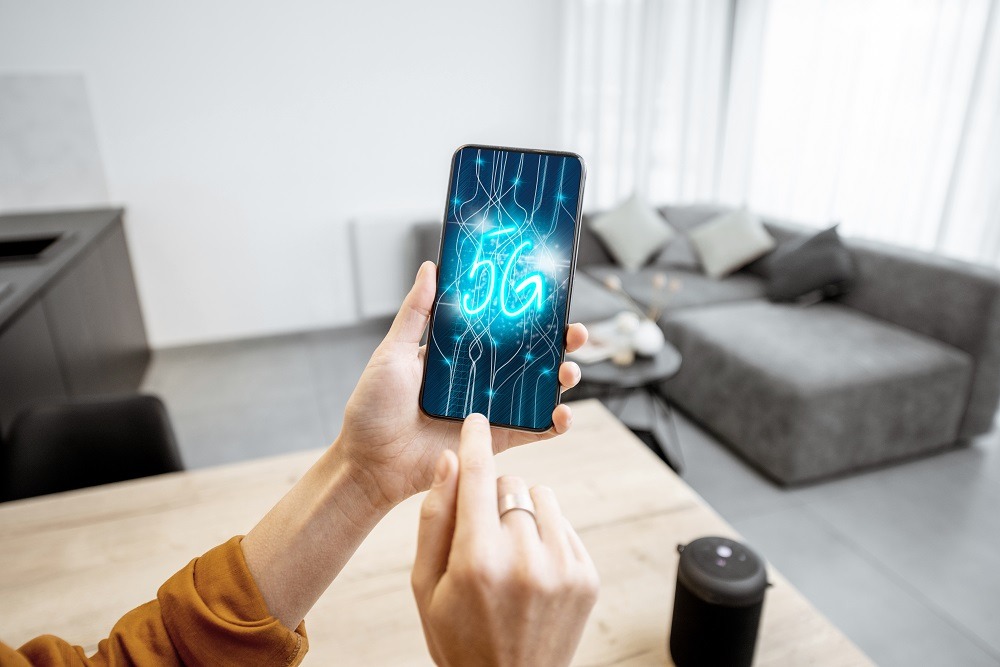5G technology is changing how we communicate, making it up to 100 times faster than 4G. This new tech allows for real-time data sharing. It also connects billions of devices, leading to smart cities and advanced automation.

5G isn’t just about speed. It also offers near-zero latency and ultra-reliable connections. This technology is a key for innovations like self-driving cars, telemedicine, and virtual reality.
Key Takeaways
- 5G technology drives the future of communication with ultra-fast data transfer.
- Enables smart cities through massive device connectivity and low latency.
- Promotes breakthroughs in healthcare, transportation, and entertainment.
- Supports the Internet of Things (IoT) by handling billions of connected devices.
- This represents a fundamental shift in how people and industries interact globally.
What Is 5G Technology and Why It Matters
5G technology is the fifth generation of wireless communication. It builds on decades of innovation. This new standard promises speeds up to 100 times faster than 4G, changing how devices connect worldwide.
Defining the Fifth Generation of Wireless Technology
Fifth-generation technology (5G) uses advanced radio frequencies and network architecture. It delivers unprecedented performance. Unlike older systems, it supports massive device connectivity without sacrificing speed. Experts like the GSMA predict 5G will connect billions of devices by 2030.
The Revolutionary Leap from 4G to 5G
| Aspect | 4G LTE | 5G |
| Speed | Up to 1 Gbps | Up to 20 Gbps |
| Latency | 50-100 ms | 1 ms or less |
| Device Density | ~100 devices/km² | ~1 million devices/km² |
Key Characteristics That Set 5G Apart
- Speed: Downloads a 2-hour movie in seconds.
- Low Latency: Real-time responses enable autonomous systems.
- Massive Connectivity: Supports smart cities and IoT ecosystems.
“5G isn’t just faster—it’s a foundation for innovation.” – Verizon 5G Technical Report
The Evolution of Wireless Communication
Wireless communication has changed a lot over the years. It started with big, old devices and now we have fast networks. Each new technology built on what came before, leading us to where we are today. Let’s take a look at this journey:
| Generation | Year | Speed | Key Features | Limitations |
| 1G | 1980s | Analogue | First mobile calls | No digital data |
| 2G | 1990s | Up to 50 Kbps | Text messages, basic data | Slow speeds |
| 3G | 2000s | 2 Mbps+ | Mobile internet, video calling | Still limited for streaming |
| 4G | 2010s | 100 Mbps+ | HD video, real-time apps | Insufficient for IoT |
Each new step fixed problems from before. 5G brings speeds up to 20 Gbps, very low latency, and can connect lots of devices. This growth isn’t just about tech—it’s a plan for the future. It’s about connecting everyone, from voice calls to smart cities.
As networks get better, so do the things we can do. The future of talking to technology and each other depends on 5G.
How 5G Networks Actually Work
Behind the scenes of the 5g network lies a blend of cutting-edge technology and strategic infrastructure. To understand how it works, start with the spectrum bands. These are radio frequencies divided into low, mid, and high ranges. Each band has its own balance of speed, coverage, and use cases:
- Low-band: Wide coverage for rural areas, slower speeds.
- Mid-band: Balances speed and coverage for urban zones.
- High-band: Ultra-fast speeds but limited range, requiring innovative solutions.
High-band frequencies use millimeter waves, which transmit data rapidly but weaken quickly over distance. To counter this, small cell towers are placed every few blocks. These compact antennas work alongside traditional cell sites to ensure consistent connectivity.
Beamforming and massive MIMO technologies further optimize signals. Unlike older systems that broadcast broadly, beamforming targets devices directly. Massive MIMO uses multiple antennas to handle hundreds of devices simultaneously, reducing lag and boosting efficiency.
Lastly, network slicing lets providers divide the 5g network into virtual “slices.” Each slice can serve unique needs—like one slice for smart city sensors and another for streaming services—all running on the same infrastructure. This flexibility makes the 5g network adaptable to diverse demands without sacrificing performance.
Transformative Benefits of 5G Connectivity
5G is more than just an upgrade; it’s a game-changer. It brings 5g benefits that open up new possibilities. With 5g speed, tasks become easier, and everyone gets connected.
Ultra-Fast Download and Upload Speeds
Imagine downloading a 4K movie in seconds or sharing live footage right away. 5g speed can reach up to 10 Gbps. This makes slow buffers a thing of the past.
This speed is not just for fun. It’s the base for new ideas like global collaboration tools and high-definition remote work.
- Download a movie in 3 seconds vs. 10 minutes on 4G
- Live-streaming 8K video without lag
- Instant cloud backups for businesses
Near-Zero Latency Communication
“Latency under 1 millisecond makes remote operations possible.” – Verizon 5G
Autonomous vehicles can react fast to traffic, and surgeons can control robots from miles away. This makes sure critical systems work together quickly.
Massive Device Connectivity
5G can handle up to a million devices per square kilometer. This means:
- Smart traffic lights adjusting in real time
- Factory sensors monitoring equipment 24/7
- Wearable health monitors sending data to hospitals
Enhanced Reliability and Efficiency
Network slicing gives hospitals, cities, and gamers their own network space. Edge computing makes data travel faster. These features save money and keep things running smoothly.
Current Applications Revolutionized by 5G
5G is changing the game in many fields. It makes downloads faster and helps build smarter cities. Big names like Verizon and AT&T are showing off 5G’s power with real projects.
- Enhanced mobile broadband: Verizon’s 5G Ultra Wideband lets you stream 4K videos and play cloud games anywhere. It cuts down on buffering time to almost nothing.
- Fixed wireless access: AT&T’s 5G Fixed Wireless Internet gives you fast home internet without needing fiber cables. It works well in both cities and rural areas.
- Smart city systems: Kansas City uses 5G sensors to make traffic lights smarter. This cuts down commute times by 20% in test areas.
- Industrial automation: Siemens uses 5G robots in factories to monitor equipment in real time. This reduces downtime by 30%.
- Augmented reality (AR): Verizon 5G Edge powers tools for remote training. Technicians can see holographic guides while fixing machines.
These examples highlight 5G’s immediate benefits. Early users get ahead with faster data, lower delays, and flexible networks. From healthcare to fun, the future of innovation is already here.
The Internet of Things and 5G: A Perfect Match
The Internet of Things (IoT) and 5G connectivity are a perfect pair. They solve old problems like slow speeds and too few devices. This combo makes systems smarter and faster in many fields.
A 2023 study by the GSMA notes that 5G could support 1 million connected IoT devices per square kilometer, revolutionizing urban and industrial spaces.
Smart Cities Infrastructure
Smart cities use 5G to connect traffic lights, pollution sensors, and emergency systems. This creates real-time networks. Here are some examples:
- Traffic systems that reroute cars instantly during accidents
- Streetlights dimmed automatically based on pedestrian activity
- Public Wi-Fi hotspots powered by IoT sensors
Connected Homes and Buildings
5G lets home devices work together smoothly. Security cameras, HVAC systems, and lights adjust on their own. Office buildings also benefit from IoT sensors.
- Optimize energy use through real-time occupancy data
- Automate fire alarms and emergency exits
- Track facility maintenance needs
Industrial IoT Applications
Factories use IoT devices with 5G for many things. They include:
- Predictive maintenance to prevent equipment failures
- Warehouse robots guided by instant data streams
- Remote quality control in manufacturing lines
From smart thermostats to self-driving trash systems, 5G makes IoT dreams real.
Industries Being Transformed Through 5G Speed
5G is changing industries with fast and reliable connections. It’s saving lives and making production lines more efficient. These changes are real and happening now.
Healthcare and Telemedicine Advancements
Hospitals like Mayo Clinic use 5G for remote surgery guidance. Wearables send patient data to doctors far away. AR tools let surgeons practice complex surgeries virtually.
Manufacturing and Industry 4.0
Factories like Siemens use 5G to control robots and IoT sensors. Assembly lines adjust quickly, and maintenance is more efficient. This cuts downtime by 30% in some places.
Transportation and Autonomous Vehicles
Companies like Tesla use 5G for vehicle-to-infrastructure communication. Self-driving cars handle traffic data fast. Fleet managers track trucks worldwide in real-time.
Entertainment and Immersive Media
Platforms like Netflix stream 8K content without lag thanks to 5G. VR concerts by artists like Travis Scott bring fans together. Cloud gaming services like GeForce Now let you play games instantly on any device.
| Industry | 5G Application | Example |
| Healthcare | Remote surgery | Mayo Clinic |
| Manufacturing | Predictive maintenance | Siemens |
| Transportation | Autonomous V2X | Tesla |
| Entertainment | Cloud gaming | GeForce Now |
Challenges and Considerations in 5G Implementation
Setting up 5g networks is tough due to technical, financial, and social hurdles. 5g tech has huge potential, but many barriers complicate real-world use.
- Infrastructure costs: Building the dense small cell networks needed for 5g requires massive investments.
- Spectrum disputes: Allocating radio frequencies fairly between regions and industries remains unresolved.
- Security risks: Vulnerabilities in 5g technology could expose critical infrastructure to cyberattacks.
- Environmental impact: Energy consumption and physical space needs strain sustainability efforts.
| Challenge | Impact |
| High infrastructure costs | Slows rural deployment |
| Security flaws | Potential data breaches |
| Spectrum shortages | Delayed service expansion |
Security worries are a big topic. 5g tech’s open design makes it more at risk than before. Tensions over who makes the hardware add to the global adoption problem. Health concerns, even though studies show no harm, keep the debate going.
Rules vary by country, leading to different standards. Finding a balance between innovation and these challenges will shape 5g’s global success. Everyone must work together to make 5g safe and fair for all.
Challenges in 5G Deployment
Despite its promising benefits, the global rollout of 5G has faced significant challenges, particularly in rural areas and developing regions. The high cost of infrastructure, slow spectrum allocation, and lack of compatible devices have delayed full-scale implementation. While urban centers in countries like the U.S., South Korea, and China have seen rapid adoption, many regions still lack the necessary infrastructure to support widespread 5G connectivity.
💡 Solution: Telecom providers are focusing on hybrid 5G networks and government-backed funding to bridge this digital divide.
Debunking 5G Health Myths
There have been widespread concerns about 5G’s impact on health, with claims suggesting that 5G radiation causes health problems. However, major health organizations, including the World Health Organization (WHO) and the Federal Communications Commission (FCC), have confirmed that 5G’s radio frequencies are non-ionizing and pose no known health risks. The radio waves used in 5G technology operate at frequencies far below harmful levels, making them safe for humans.
✅ Fact Check: Scientific studies have shown no correlation between 5G networks and adverse health effects.
Monetization Challenges in 5G Adoption
While 5G technology brings faster speeds and better connectivity, telecom companies are struggling to turn a profit from these advancements. Consumers have been slow to adopt premium 5G plans, and business applications are still developing. This has led telecom providers to explore new monetization strategies, such as:
• Network Slicing – Offering customized, premium services for industries like healthcare and gaming.
• Private 5G Networks – Selling dedicated high-speed networks to corporations and institutions.
• Edge Computing Services – Partnering with enterprises to deliver ultra-low-latency computing solutions.
These strategies aim to ensure that 5G investments become financially viable while unlocking new revenue streams.
Conclusion: Embracing the 5G-Powered Future
5G technology is more than just an upgrade. It’s a key part of our future communication. It offers ultra-fast speeds and low latency, changing how we use technology and connect.
From smart cities to remote healthcare, 5G does more than just speed up downloads. It makes connections that were once thought impossible.
As 5G networks grow, we all need to get ready. Businesses in healthcare, manufacturing, and entertainment are already seeing big changes. People will enjoy seamless smart home experiences and immersive entertainment.
The full power of 5G will show as more infrastructure is built and new uses are found. It will change industries for years to come.
The future of communication relies on 5G’s ability to connect billions of devices in real-time. This technology is not just a trend. It’s the foundation of tomorrow’s digital world.
Keeping up with 5G news helps us prepare for a future where connection drives progress. The 5G era has started, and its influence will only grow as innovation speeds up.
FAQ
Q1: What is 5G technology?
5G technology is the newest in wireless communication. It makes mobile networks much faster and more reliable than 4G. This means you can download things much quicker and stream videos without interruptions.
Q2: How fast is 5G compared to 4G?
5G is incredibly fast, reaching speeds of up to 10 Gbps. This is about 100 times faster than 4G. It allows for super-fast downloads and smooth streaming of high-definition content.
Q3: What are the main benefits of 5G connectivity?
5G offers many benefits. It has ultra-fast speeds, almost no delay, and can connect lots of devices at once. This makes it perfect for advanced apps and better digital experiences.
Q4: How does 5G impact the Internet of Things (IoT)?
5G is a game-changer for IoT. It provides the bandwidth and speed needed for IoT to work on a large scale. This opens up new possibilities for smart cities, homes, and industries.
Q5: What types of applications are currently leveraging 5G?
Many applications use 5G today. These include fast downloads, home internet, smart cities, and even virtual reality. It’s changing how we live and work.
Q6: What challenges does 5G implementation face?
Implementing 5G comes with challenges. It requires a lot of investment in new infrastructure. There are also issues with spectrum, security, and different regulations in different places.
Q7: How does 5G support autonomous vehicles?
5G is key for self-driving cars. It offers low latency and reliable communication. This is crucial for vehicles to make quick decisions and stay safe on the road.
Q8: Will 5G really change how we communicate?
Yes, 5G will change how we talk and connect. It brings high-speed connectivity that opens up new possibilities. It will make our communication faster, more efficient, and smarter.
















